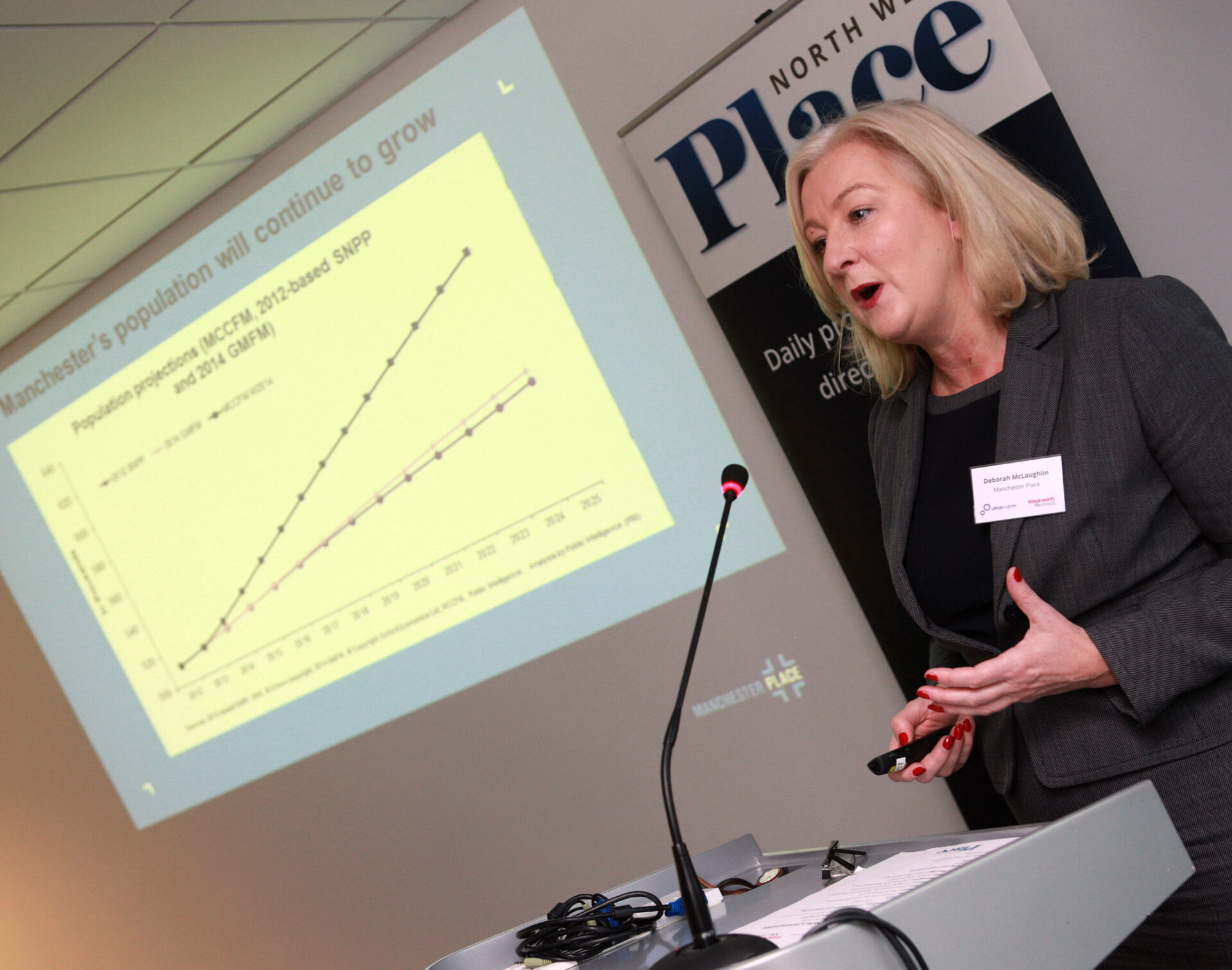Event Summary
Building Successful Communities | Summary, slides + images
Overseas investors are “desperate” to break into the Manchester private rented residential sector, according to Deborah McLaughlin, chief executive of Manchester Place.
 Speaking at Place North West’s Building Successful Communities event, held at City Tower and sponsored by Winckworth Sherwood and UrbanBubble, McLaughlin described PRS as “the fastest growing and most attractive tenure” in Manchester. She attributed the appeal of high-quality rented accommodation to the fact that it “houses a real mix of people, whether that’s mature downsizes, low income families or young professionals.
Speaking at Place North West’s Building Successful Communities event, held at City Tower and sponsored by Winckworth Sherwood and UrbanBubble, McLaughlin described PRS as “the fastest growing and most attractive tenure” in Manchester. She attributed the appeal of high-quality rented accommodation to the fact that it “houses a real mix of people, whether that’s mature downsizes, low income families or young professionals.
Scroll down for link to presentations + photo gallery
“The market is definitely now maturing and we’re getting endless enquiries from overseas investors desperate to get into the Manchester market.”
McLaughlin discussed how successful communities could be built using the build-to-rent model, which is being utilised across a number of sites which Manchester Place is supporting.
According to McLaughlin, Manchester residents are already ahead of the curve when it comes to renting their homes.
“Around a third of Mancunians rent privately, which is certainly not the standard nationally, so we don’t have to change the mindset of our residents, they’re already on board.
“Rental growth has been impressive, reaching 15% last year according to JLL, but we wouldn’t suggest that landlords should expect that every year,” she warned.
Manchester Place was launched in 2015 and is a collaboration between Manchester City Council and the Homes & Communities Agency, and aims to support the construction of 55,000 new homes by 2027. Out of a loan pot of £300m launched in summer 2015, £65m has already been committed. Focus areas are Ancoats, New Islington, Piccadilly Gateway, New Cross and Collyhurst.
The organisation is accelerating land disposals for residential development across Greater Manchester, including the former Stagecoach site in Moss Side, the car park at Little Peter Street, and plots at NOMA’s Angel Meadow. It is also due to appoint a development partner for the Northern Gateway, which is earmarked for 7,000 homes.
In total, McLaughlin said that there were 20,000 homes currently in the pipeline. Across the city, 37% of residential schemes being delivered before 2018 are PRS projects backed by institutional funders.
Alongside McLaughlin, an expert panel from across the residential sector spoke at Building Successful Communities, and examined the role of new developments in creating thriving city centre communities.
Regenerating communities
First to present was Mike Horner, regional director of Muse Developments, a national mixed-use developer with 5,500 residential units in its portfolio and a strong regional presence for decades. Horner talked the audience through the Muse’s ongoing regeneration of the Smithfield area of the Manchester’s Northern Quarter, which started in 1999 and is due to complete in 2017.
On a 4.5-acre site, the phased project has so far delivered 13 retail units and 420 homes, alongside Crowne Plaza and Holiday Inn hotels, in what was once a down-at-heel area of the city.
Within Smithfield is a residential block lauded as Manchester’s first private rented sector development, however Horner emphasised that One Smithfield was in fact not designed for PRS but responded to demand in the market.
“Smithfield has knitted together well, and knitted well into the Northern Quarter,” Horner said. “We’re hoping to deliver something similar at Chapel Street.”
As part of its Salford Central project, being delivered in a joint venture with the Homes & Communities Agency and Legal & General under the name English Cities Fund, Muse is building offices, leisure, and homes along Chapel Street. The first residential element, Vimto Gardens, completed last year, with all 97 units sold off plan.
“We were very much focused on avoiding an ‘us and them’ mentality at Vimto Gardens with the nearby affordable housing, or old versus the new,” said Horner. “All of the apartments and townhouses are outward facing, and we’ve worked with nearby landlords to bring forward refurbishments of facades to integrate the development with the surrounding area.”
The next phase of homes in Chapel Street, 36 townhouses at Timekeeper Square, designed by Buttress, is due to complete in the summer. ECf has also secured funding for two PRS blocks at the nearby New Bailey, totalling 230 homes.
Aspirational living
As a specialist in PRS property management, Michael Howard of UrbanBubble defined the parameters of what could be truly defined as a private rented sector scheme.
“City centre-based apartment schemes, designed, built and managed for rent, with one asset owner and one asset manager,” he said. “We work to the tagline that private rented communities ‘create a place where everyone aspires to live’.”
Fresh from a market research tour around New York and Philadelphia, Howard laid out intelligent features that he had noticed in US projects could be included within a PRS design to ensure that customer need was the first priority.
“It’s crucial that you get the amenity right in PRS, or people will go somewhere else,” he stressed. “Certain features such as media rooms and outdoor space are well used, as are working from homes rooms, which provide residents with space to plug in and go, including with printers and scanners.
“Considering details such as parcel management and waste management strategies are also essential, otherwise they can have a big negative impact on the day-to-day functionality of the building.”
Joining Horner, McLaughlin and Howard for a panel discussion after the presentations was James Alderson, head of developer Mulbury City, James Duncan, partner, corporate and funds, at law firm Winckworth Sherwood, and Jon Matthews, director, 5plus Architects.
When asked about whether the PRS model supported the more aspirational household, the panel was overwhelmingly positive.
“Gone are the days where renting is looked down on,” asserted Horner. “In their 30s and 40s, families are now choosing to live in well-managed blocks.”
Who needs to buy?
As Howard pointed out, the younger generation were looking to rent everything. “Millenials do every later, and rent everything. They don’t own films, they have Netflix, they don’t own music, they have Spotify. Why not the same with homes if the end product is actually better?”
Matthews of 5plus agreed: “As the market matures we will undoubtedly see a move away from ownership, especially as the shame of renting as a family disappears. I think we’re still 20 years away from that model being as standard though.
He continued: “In order to make PRS a success, density is good, with a range of flat types. With something the size of a 400-unit scheme, you need to look at how that integrates with the urban environment, how it contributes positively to the streetscape. You can also design for a mix of tenants, from students to hyper high-end.”
Mulbury’s James Anderson, who was hired at the end of last year to oversee the social landlord’s expansion into the city centre PRS market, outlined the developer’s plans in Manchester.
“At Port Street in the Northern Quarter, that is our first PRs scheme and that will deliver 120 flats, aimed at creating a sense of community spirit. We have a second site nearby that is going in for planning in March, and a third site which we will submit an application for in June.
“We have institutional investors involved in the schemes, and are focusing on good design and flexibility.”
Delivery remains slow
Winckworth Sherwood’s James Duncan stressed that while the market may have returned, funding for PRS schemes was by no means easy.
“Money is out there, but it’s still as hard to access as it ever was. If it wasn’t, we wouldn’t have things like Deborah’s Manchester fund up here to help oil the cogs. Viability is strong in Manchester, so it is attractive to institutional investors, although to date funds have been slow to look up North.
“There are lots of funding options out there though, and the simplest could be forming joint ventures. Financing PRS is like student housing 10 or 15 years ago. We don’t have an Irish Bank or RBS to fall back on anymore though, but funding is moving in the right direction.”
While PRS has been a buzzword for a number of years, the panel conceded that the delivery of projects designed specifically for private rent had been slow.
“Pure PRS schemes are taking a while to come out of the ground,” said Matthews. “However the next six months will be telling, as there are thousands of units planned, and hundreds due to be imminently delivered.”
According to Howard: “There is demand so PRS has to happen, and will deliver thousands of homes. That will also have the knock on effect that older stock will fall in value allowing for more affordable living in the city centre.”
Other questions to the panel looked at skills shortages and construction costs, flexibility of tenure, and local authorities replacing central government as funders.
Click here to view and download presentation slides from Slideshare
Click any image below to launch gallery
- McLaughlin led the panel at Place North West's recent Building Successful Communities event
- Mike Horner, regional director of Muse Developments
- Michael Howard, managing director of urbanbubble
- James Duncan, partner at Winckworth Sherwood
- James Alderson, head of Mulbury City
- Mike Horner, regional director of Muse Developments
- Deborah McLaughlin, Manchester Place
- Michael Howard, urbanbubble
- Michael Howard, urbanbubble
- Paul Unger, Place North West, chaired the discussion































